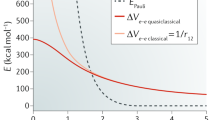Abstract
A comparison of the results of a semi-empirical molecular orbital calculation for OF2 with the empirical interaction force constants for OF2, NF2 and CF2 leads to the conclusion that electron delocalization, of a type commonly identified as no bond-double bond resonance, strongly influences the magnitude of the interaction constants for these molecules. This analysis further suggests that Urey-Bradley fluorine-fluorine non-bonded interaction constants for polyfluorinated molecules may commonly be inflated by such resonance. It was expected that the MO calculation would also help clarify the origin of the unusual stability of polyfluorinated systems, but the results are largely inconclusive on this point.
Zusammenfassung
Ein Vergleich der Ergebnisse einer semiempirischen MO-Rechnung für OF2 mit den empirischen Wechselwirkungs-Kraftkonstanten für OF2, NF2, CF2 führt zu dem Schlu\, da\ Elektronendelokalisierung unter Beteiligung ionischer Resonanzstrukturen die Grö\e der Wechselwirkungskonstanten dieser Moleküle stark beeinflu\t. Diese Analyse führt ferner zu dem Ergebnis, da\ die Urey-Bradley-Wechselwirkungskonstanten der „nicht gebundenen“ Fluoratome im allgemeinen durch eine solche Resonanz stark vergrö\ert würde. Die MO-Berechnungen geben aber entgegen den Erwartungen keinen Beitrag zur KlÄrung der ungewöhnlichen StabilitÄt polyfluorierter Systeme.
Résumé
Une comparaison de résultats de calculs semi-empiriques d'orbitales moléculaires pour OF2 avec les constantes de force d'interaction empiriques pour OF2, NF2 et CF2 conduit à conclure que la délocalisation électronique du type habituellement identifié comme résonance liaison-double liaison, a une influence sur la grandeur des constantes d'interaction de ces molécules. Cette analyse suggère en outre que les constantes d'interaction de Urey-Bradley entre atomes de fluor non liés des molécules polyfluorées peuvent Être exaltées par une telle résonance. On pouvait espérer que les calculs d'orbitales moléculaires aideraient à comprendre la raison de la stabilité inhabituelle des systèmes polyfluorés, mais les résultats obtenus ne sont pas concluants.
Similar content being viewed by others
References
Hine, J. T.: J. Amer. chem. Soc. 85, 3239 (1963).
Tables of interatomic distances and configuration in molecules and ions. Special Publication No. 16. London: The Chemical Society 1958.
Wilson, E. B.: Symposium on molecular structure and spectroscopy. Paper A1. The Ohio State University 1963.
Devlin, J. P.: J. chem. Physics 41, 2951 (1964).
Duchesne, J., and L. Burnelle: J. chem. Physics 19, 1191 (1951).
Pierce, L., N. DiCianni, and R. H. Jackson: J. chem. Physics 38, 730 (1963).
Herzberg, G.: Infrared and raman spectra of polyatomic molecules, p. 154. D. Van Nostrand Company Inc. 1945.
Morino, Kuchitsu, and T. Shimanouchi: J. chem. Physics 20, 726 (1952).
For example see References [5] and [6].
Linnett, J. W., and M. F. Hoare: Trans. Faraday Soc. 44, 884 (1949).
Brockway, L. O.: J. physic. Chem. 41, 185 (1937).
Pohl, H. A., R. Rein, and K. Appel: J. chem. Physics 41, 3385 (1964).
Parr, R. G.: The quantum theory of molecular electronic structure. New York: W. A. Benjamin 1964.
Roothaan, C. C. J.: Rev. mod. Physics 23, 69 (1951).
Herman, F., and S. Skillman: Atomic structure calculations. New York: Prentice-Hall, Englewood Cliffs 1963.
Hinze, J., and H. H. Jaffe: J. Amer. chem. Soc. 84, 540 (1962)
Hinze, J., and H. H. Jaffe: J. physic. Chem. 67, 1501 (1963).
The valence state values were obtained from ground state ionization potentials and electron affinities and from promotion energies which have been published by Hinze and Jaffe [16] and from an Air Force report which may be obtained from Professor Jaffe.
Pohl, H. A., and L. M. Raff: Int. J. quant. Chem. 1, 577 (1967).
Duncan, J. L., and I. M. Mills: Spectrochim. Acta 20, 1089 (1964).
For example, L. C. Cusachs, in a private communication, has questioned the wisdom of incorporating the s electrons into the “non-polarizable” core.
Kaufman, J. J.: J. chem. Physics 37, 759 (1962).
Author information
Authors and Affiliations
Rights and permissions
About this article
Cite this article
Bruns, R., Raff, L. & Devlin, J.P. A theoretical study of the bond-bond interaction force constant in XF2 molecules. Theoret. Chim. Acta 14, 232–241 (1969). https://doi.org/10.1007/BF00527281
Received:
Issue Date:
DOI: https://doi.org/10.1007/BF00527281




